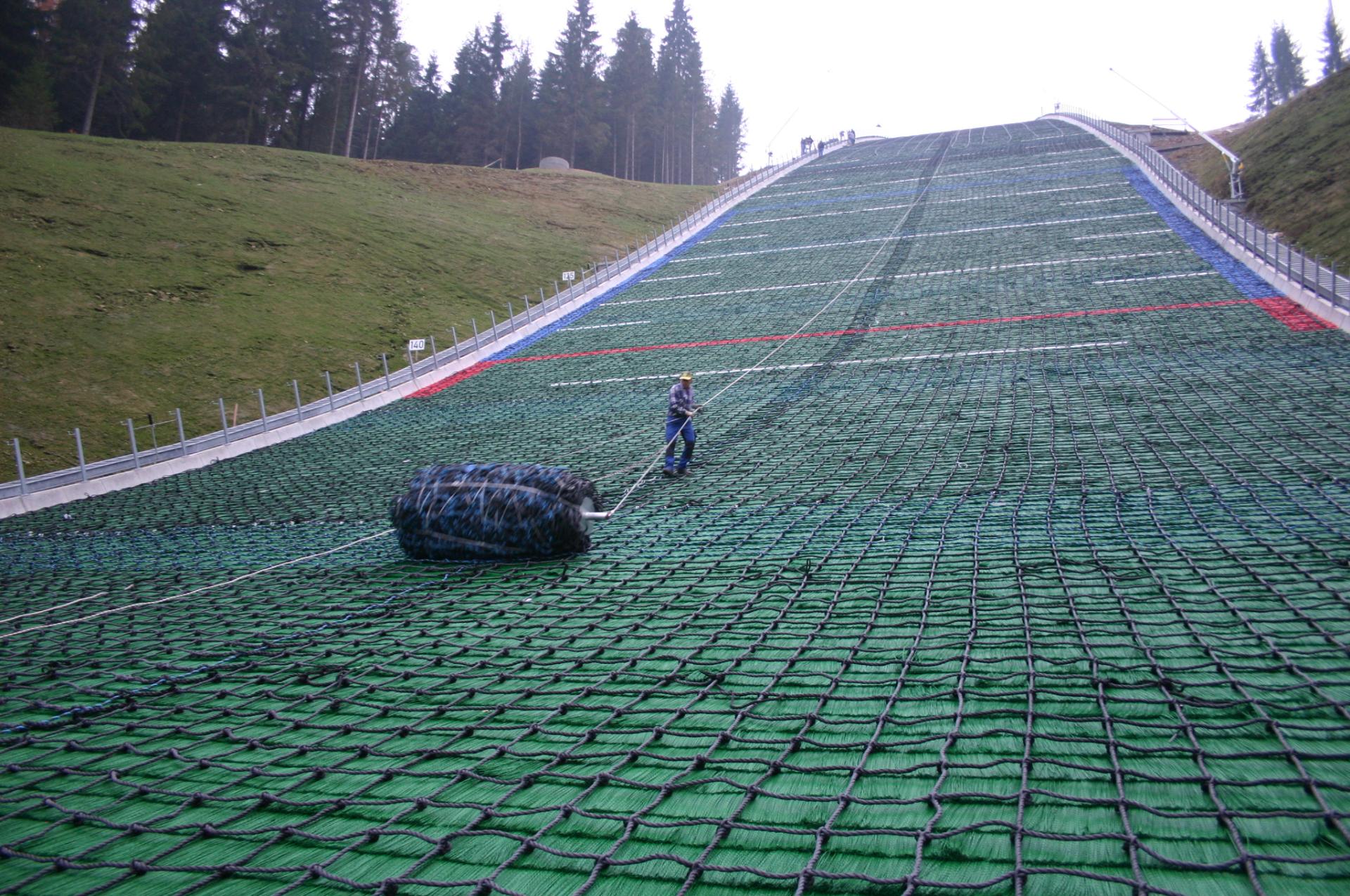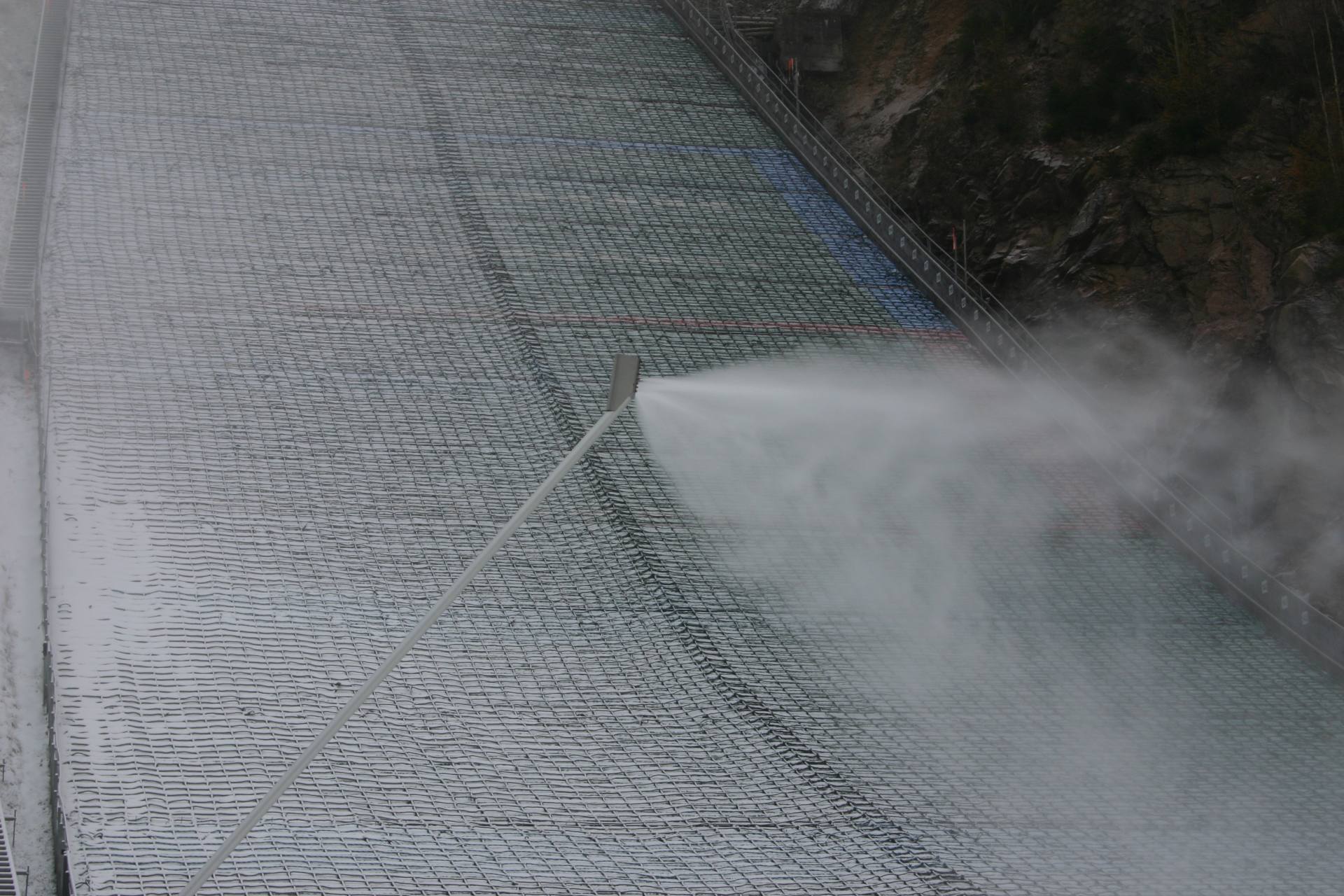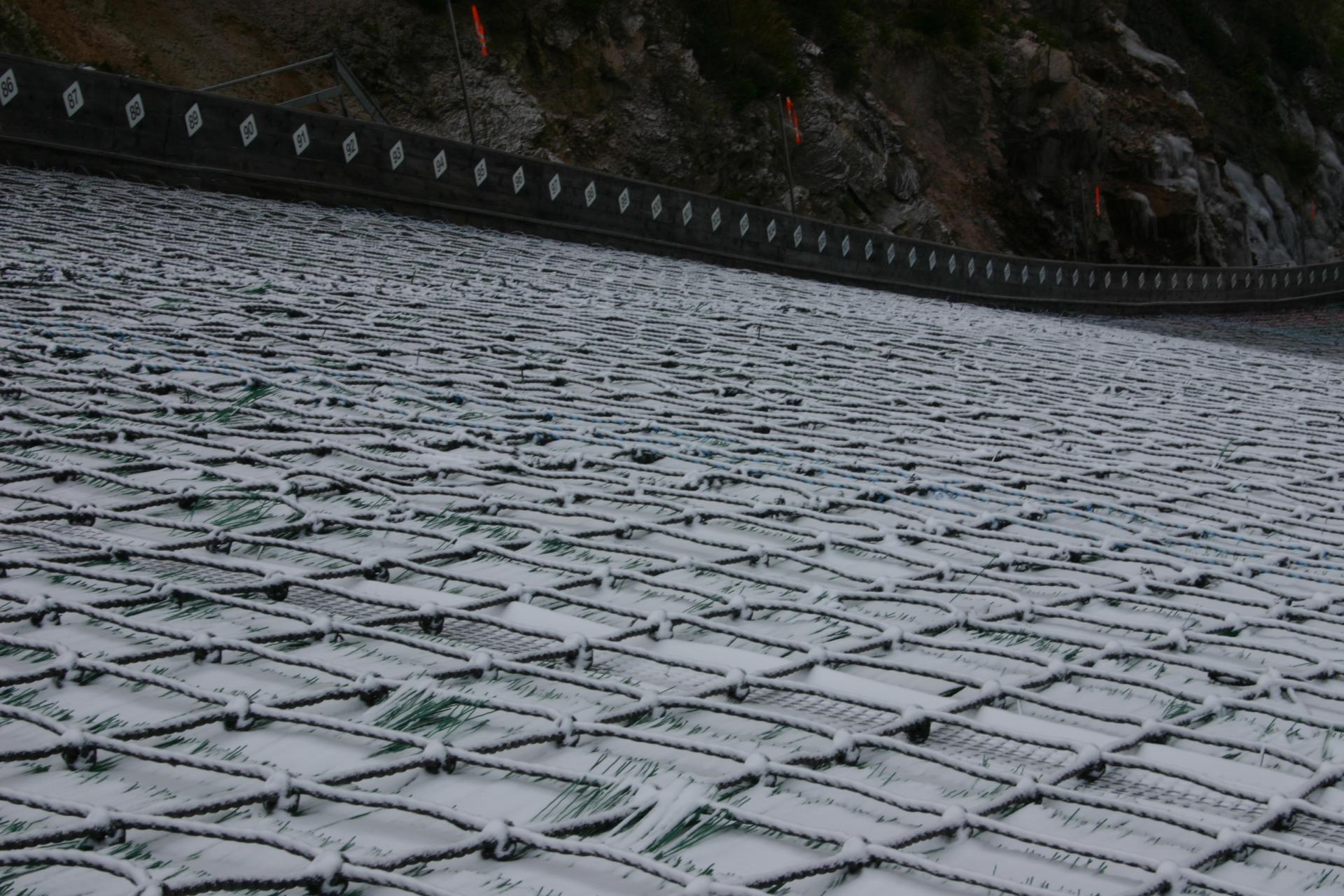Snow retention system
Concepts for the refitting of ski-jumps
with mat coverings for winter operation
Use summer ski jumps throughout the year
For small and large platforms: K15 to K180
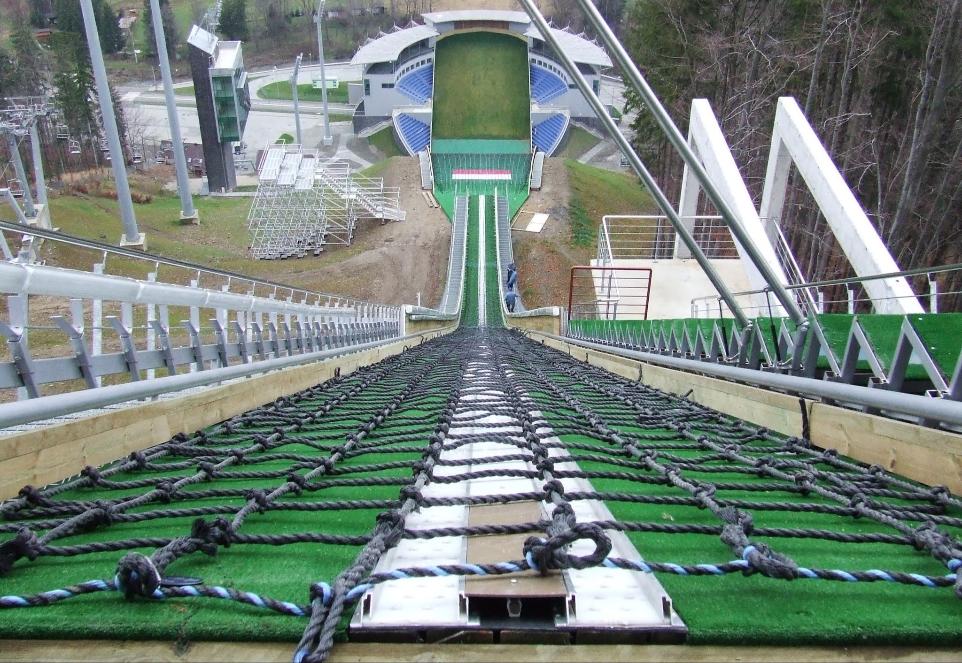
Nets can be deployed on the inrun and landing slope.
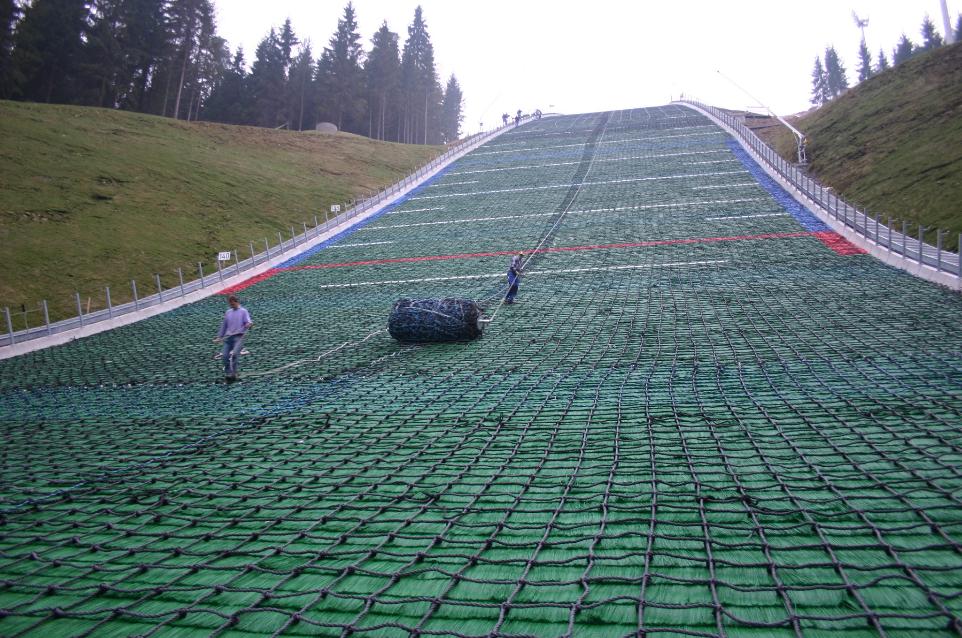
The net which is made from strong plastic rope
offers reliable resistance to any slipping of the snow.

The robust and lightweight material is stabilized against UV-radiation and has a long lifespan. A fastening device gives the net additional stability.
Quick and easy to install
Perfected assembly technique
The assembly of the snow retaining nets is relatively simple. The snow retention system is mounted onto the ski-jump before
the winter season. The net is delivered as large bales, which are rolled out and folded out and fixed onto the platform. The size of the bales can be determined according to the customer’s requirements for each project.
Rapid installation saves running costs
This assembly system is extremely efficient. A well trained team of 6 persons can cover a K90 platform in five to eight hours for example. The disassembly in spring normally requires less time. The personnel costs are therefore kept to a minimum.
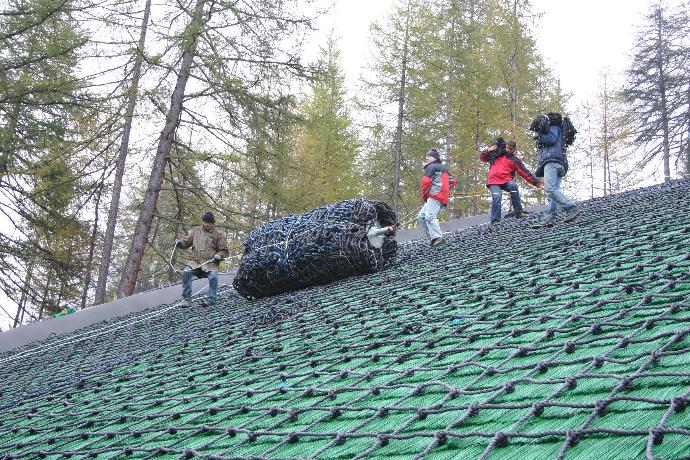
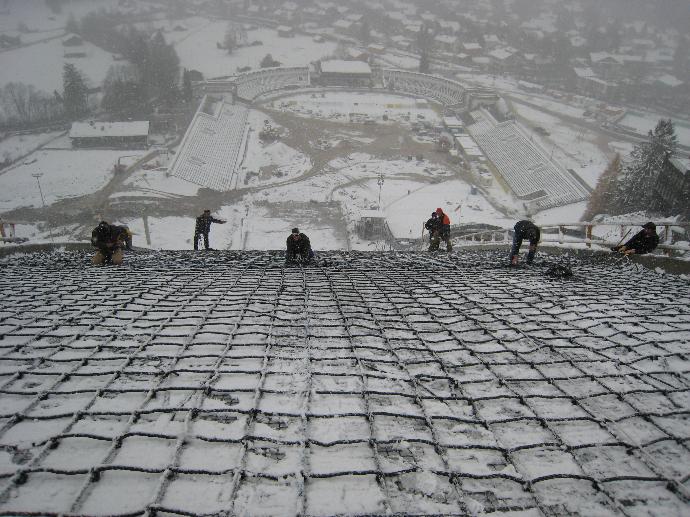
Installation supervision and instruction by technical personnel for the first assembly
The first installation of the SEIL-FREY snow retention system is supervised by a specialist from SEIL-FREY snow retention systems GmbH. At the same time ski-jump employees are trained in the assembly technique so that they can perform this without supervision in subsequent years.
Safety for users and designers
Snow retention concepts are important for the design of the ski-jump
Technically perfected snow retention systems are extremely important for the success of the all year round ski-jumps.
The demands placed on it are high:
-
The loads created by the snow must be carried safely.
-
It should function reliably during winter operations both with little or large quantities of snow.
-
Preparation of the snow using slope preparation equipment must also be possible.
-
Annual assembly must be easy and inexpensive.
Calculating the dimensions on the basis of static load calculations
The snow retaining net has the task of keeping up to 800 tons of snow from slipping. The snow retaining system must be capable of dealing with this load during a haw. A design for the load bearing of every platform is developed according to the known local snowfall statistics, and in consideration of any deployment of slope preparation vehicles. The dimensions of the load bearing system are determined on the basis of these calculations.
Alternative load-bearing concepts are possible
In general, various fastening concepts with differing advantages are feasible for snow retention systems, e.g. via wire ropes parallel to the ski-jump axis or parabolic shaped cables or via numerous anchor points directly fixed onto the concrete surface of the platform.
The renovation of jumping platforms
In the case of renovations or reprofiling, fastening concepts can be developed which use existing structural components such as concrete foundations, for example.
Construction of new ski-jumps
Various technical solutions are available for new building projects. In this case, we recommend a decision on the type of anchoring system early in the planning phase. Optimum solutions can then be found with respect to price and technical implementation.
Please contact us for a free consultation with our specialist engineer.
SEIL-FREY snow retention system
Recommended by satisfied customers
As a manufacturer of ropes and nets, we have made snow retention systems for ski-jumps with plastic mats since 1980. Close cooperation with many designers, ski-jump operators and technicians has enabled us to develop a system that has proved itself on over 120 ski jumps. Close cooperation with our customers is for us an important prerequisite for the successful further development of our product.
These customer comments are taken from actual letters sent to the company SEIL-FREY GmbH.
Operating internationally since 1980
|
Bischofshofen |
HS142 |
2003 |
|
Bischofshofen |
K20 |
1996 |
|
Eisenerz |
HS15, HS35, HS70, HS109 |
2015 |
|
Hinzenbach |
K20/HS47 |
2004 |
|
Hinzenbach |
HS90 |
2009 |
|
Höhnhart |
HA15, HA30, HS55 |
2009 |
|
Innsbruck |
HS128 |
2001 |
|
Kitzbühel |
K40 |
2012 |
|
Murau |
K20, K35 |
2003 |
|
Mürzzuschlag |
HS65 |
2004 |
|
Ramsau |
HS98 |
1995 |
|
Rottenmann |
K10/K15, K30, K45 |
2003 |
|
Saalfelden |
K30, HS65 |
2003 |
|
Saalfelden |
K45 |
1993 |
|
Stams |
K60, K105 |
1989 |
|
Tschagguns |
HS22, HS40, HS66, HS108 |
2013 |
| Villach |
K15, HS32, HS65, HS98 |
1995 |
| Schwarzach |
HS55 |
2017 |
| Einsiedeln |
HS50, HS77 |
2005 |
| Gibswil |
HS15/HS25 |
2012 |
| Gibswil |
HS67 |
2006 |
| Kandersteg |
HS72, HS106 |
2015 |
| Wildhaus |
HS15, HS30, HS45 |
1989 |
|
Berchtesgaden |
K30 |
1994 |
|
Berchtesgaden |
HS98 |
1999 |
|
Bischofsgrün |
K57 |
1983 |
|
Bischofsgrün |
HS71 |
2002 |
|
Braunlage |
K57 |
1988 |
|
Breitenberg |
K15, K35, K75 |
1989 |
|
Breitenberg |
HS78 |
2012 |
|
Furtwangen |
K85 |
1985 |
|
Garmisch-Partenkirchen |
HS142 |
2007 |
|
Garmisch-Partenkirchen |
HS89 |
2002 |
| Hinterzarten |
K15, K30 |
2004 |
| Hinterzarten |
HS77 |
2005 |
| Hinterzarten | K90 |
1981 |
| Hinterzarten |
HS109 |
1999 |
| Isny |
K15, K30, K60 |
1995 |
| Johanngeorgenstadt |
K13/K21, K36/HS55 |
2005 |
| Klingenthal |
HS85/HS65 |
2012 |
| Klingenthal |
HS140 |
2005 |
| Meßstetten |
K20 |
1999 |
| Meßstetten |
K40 |
1992 |
| Oberhof |
HS140 |
1998 |
| Oberhof |
HS70 |
2008 |
| Oberhof |
HS100 |
2002 |
| Oberstdorf |
K30 |
2000 |
| Oberstdorf |
K90 | 1997 |
| Oberstdorf |
K56, K120 |
2003 |
| Oberwiesenthal |
HS105 |
2001 |
| Reit im Winkl |
K55 |
1986 |
| Ruhpolding |
K20 |
2004 |
| Willingen |
K25/K45 |
2005 |
| Winterberg |
HS47 |
1985 |
| Winterberg |
HS87 |
2006 |
| Zella-Mehlis |
HS34 |
2010 |
| Oberstdorf |
HS20, HS40, HS75, HS106, HS140 |
2010 |
| Oberstdorf |
HS213 |
2016 |
| Oberstdorf |
HS25, HS42, HS106, HS137 |
2019 |
| Liberec | K120 |
2001 |
| Libere |
HS100, HS134 |
2008 |
| Beijing / Shougang | Big Air |
2019 |
| Yabuli | HS100 |
2019 |
|
Zhangjiakou |
HS105, HS70, HS40, HS25, HS15 |
2019 |
| Chamonix | HS40 | 2015 |
| Chaux-Neuve | K57 | 1991 |
| Courchevel | K60 | 2004 |
| Courchevel |
K90, K120 |
1990 |
| Gerardmer | HS72 | 2010 |
| La Bresse | HS44 | 2011 |
| Gallio | HS66 | 2006 |
| Pellizzano | HS38 | 2012 |
| Pragelato | K15, K30, HS66, HS106, HS140 | 2005 |
| Predazzo | HS104, HS135 | 2005 |
| St. Christina | K20/K30 | 2006 |
| Tarvisio | K21, K31 | 2006 |
| Oslo |
HS106, HS134 |
2009 |
| Trondheim | HS105, HS138 |
2010 |
| Szczyrk | HS75 | 2008 |
| Wisla | HS10, HS20, HS40 | 2015 |
| Wisla | HS134 | 2008 |
| Zakopane | HS140 |
2003 |
| Zakopane |
HS15, HS25, HS40, HS70, HS105 |
2020 |
| Kuusamo | HS142 |
1995 |
| Kranj | HS109 |
2004 |
| Ljubno | HS 94 |
2018 |
| Planica | HS15, HS30, HS45, HS60, HS85, HS104, HS135 |
2012 |
| Strbské Pleso | HS100 |
1998 |
| Falun |
HS134 |
2014 |
We offer the following services:
-
A cost-free consultation in the planning phase
-
Reliable information about the load conducting points of the snow retention system
-
The delivery of the snow retaining net for the inrun
-
The delivery of the snow retaining net for the landing slope
-
Instructions for use
-
Calculation of statics
-
Free, phone service
-
Five-year guarantee
-
Free hotline for all questions concerning snow retention

